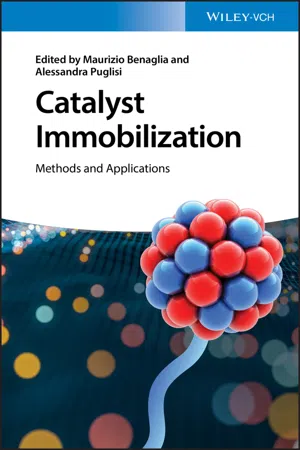
- English
- ePUB (mobile friendly)
- Available on iOS & Android
About This Book
A comprehensive resource on techniques and applications for immobilizing catalysts Catalyst Immobilization: Methods and Applications covers catalyst immobilization topics including technologies, materials, characterization, chemical activity, and recyclability. The book also presents innovative applications for supported catalysts, such as flow chemistry and machine-assisted organic synthesis. Written by an international panel of expert contributors, this book outlines the general principles of catalyst immobilization and explores different types of supports employed in catalyst heterogenization. The book?s chapters examine the immobilization of chiral organocatalysts, reactions in flow reactors, 3D printed devices for catalytic systems, and more. Catalyst Immobilization offers a modern vision and a broad and critical view of this exciting field. This important book: -Offers a guide to supported and therefore recyclable catalysts, which is one of the most important tools for developing a highly sustainable chemistry
-Presents various immobilization techniques and applications
-Explores new trends, such as 3D printed devices for catalytic systems
-Contains information from a leading international team of authors Written for catalytic chemists, organic chemists, process engineers, biochemists, surface chemists, materials scientists, analytical chemists, Catalyst Immobilization: Methods and Applications presents the latest developments and includes a review of the innovative trends such as flow chemistry, reactions in microreactors, and beyond.
Frequently asked questions
Information
1
Strategies to Immobilized Catalysts: A Key Tool for Modern Chemistry
1.1 Introduction

Table of contents
- Cover
- Table of Contents
- Preface
- 1 Strategies to Immobilized Catalysts: A Key Tool for Modern Chemistry
- 2 Catalysts Immobilized onto Polymers
- 3 Modified Nanocarbons as Catalysts in Organic Processes
- 4 Stereoselective Synthesis by Catalysts Supported on Magnetic Nanoferrite
- 5 Metal–Organic Frameworks as Catalysts
- 6 Alternative Solvent Systems in Catalysis
- 7 Immobilized Chiral Organocatalysts
- 8 Catalyst Recycling in Continuous Flow Reactors
- 9 Membrane Reactors
- 10 Development of Polymer‐Supported Transition‐Metal Catalysts and Their Green Synthetic Applications
- 11 3D Printed Devices for Catalytic Systems
- 12 General Overview on Immobilization Techniques of Enzymes for Biocatalysis
- 13 Immobilized Enzymes: Applications in Organic Synthesis
- Index
- End User License Agreement